“If you get the toilets right, you get the teaching right.”
So said Schools’ Minister David Miliband, somewhat bizarrely in 2004. Well, are schools getting it right?
Not according to a 2010 report which suggested that one in four secondary pupils thought their school toilets were “disgusting”, 38% of secondary school girls admitted to “holding it in” to avoid going to the toilet while at school, and 27% of secondary school boys said they never use soap at school. On top of that, 36% believed the school toilets were “never clean”.
How to improve things? Roll out the unisex ‘gender neutral’ toilets!
On 22/8/18, The Scottish Sunday Herald and The Scottish Sun announced that parents, who had not been consulted or forewarned of the changes, were not happy about the new ‘gender neutral’ toilets installed in Carolside and Braidbar Primary Schools. One paper referred to the action as, ‘highly inappropriate’.
Local councilor David MacDonald observed:
“…this has left some parents worried, angry and upset, particularly parents of girls approaching and going through puberty and those who need private spaces to deal with menstruation… Boys urinate on toilet seats whether by accident or on purpose. Are girls expected to enter a cubicle and be charged with having to wipe down a toilet seat with toilet paper to get rid of the urine and then be forced to make direct skin contact with the toilet seat when they sit down? I can’t imagine how incredibly unsanitary that situation will be, not to mention absolutely disgusting.”
Chris McGovern, former TUC member & chairman of the Campaign for Real Education stated:
“Girls, in particular, are likely to feel threatened and some may simply refuse to use the toilets. The council… needs to undergo a course of detoxification in order that common sense can be restored to its thinking. In the meantime, I fear for the well-being of the children.”
Whilst this is the story currently in the public eye, the unisex toilet debate is not an entirely new one. One of the first secondary schools to establish unisex toilets was Bramhall High School in Stockport, way back in 2000. The headteacher claimed it would ‘prevent bullying, vandalism and smoking.‘ At the time the Department for Education ruled, “the time is not right for the introduction of unisex toilets in our schools”, saying they were technically illegal.
Roll on a few more years, and in 2016, over 700 parents signed a petition to protest against ‘gender neutral’ toilets opening at a London primary school, concerned that this might result in an increase of sexual assaults. In every case I have read about while researching this article, parents who object to unisex toilets say the school did not consult them before the changes were made.
Supporters of the scheme have pointed out that these are ‘only’ primary schools. That doesn’t allow for the fact that plenty of girls start their periods while at primary school. I was eleven when I started my periods, & while I had just started at secondary, there were girls in my year who had started before me. I remember being embarrassed to unwrap a Tampax in the loos on occasion: if boys had been using the same bathrooms I would have been mortified. No: women aren’t exaggerating, men, when we say we often get blood on our fingers when we have our periods. We are changing tampons and blood -soaked pads! Sometimes the water does run red in the sinks and occasionally we do need to rinse out underwear, or pad our knickers out with paper hand towels from the communal area. No, we’re not over the moon about that either. As for the growing popularity of the Mooncup, a healthier and more environmental option to pads and tampons, what young woman is going to want to rinse her menstrual blood down the sink with a group of boys watching? That knocks that one on the head.
Establishing unisex toilets in primary schools could result, for example, in a five year old girl sharing toilet facilities with an eleven year old boy, a potentially uncomfortable and intimidating situation for both.
Whilst the schools featuring in the press this month are primary schools, there are several secondary schools which have already brought in the idea.
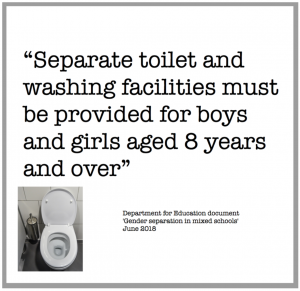 While the popularity of ‘gender neutral’ toilets is growing, by law single sex toilets must be provided for children in school over the age of eight. As recently as June 2018 the Department for Education document ‘Gender separation in mixed schools’ (non-statutory guidance) stated:
While the popularity of ‘gender neutral’ toilets is growing, by law single sex toilets must be provided for children in school over the age of eight. As recently as June 2018 the Department for Education document ‘Gender separation in mixed schools’ (non-statutory guidance) stated:
“Separate toilet and washing facilities must be provided for boys and girls aged 8 years and over pursuant to Regulation 4 of the School Premises (England) Regulations 2012, which falls within the exemption provided for in Schedule 22 of the Equality Act 2010.”
As long as schools keep access to some single-sex toilets available to students, they are allowed to establish ‘gender neutral’ or unisex toilets in new-build or refurbished schools. Sometimes they can be a cost-cutting measure: one set of toilets is cheaper to built and maintain than two and, where staff supervision is provided, a single bathroom area is easier to supervise.
It is unlawful for schools to act in a way incompatible with the European Convention on Human Rights. These rights include Article 8: the ‘right to respect for private and family life’ which includes a duty to protect the individual’s physical and psychological integrity. One student complained that the ‘girls’ toilets were much further away from the main areas of the school, and less well maintained. If a menstruating girl is forced to wash blood from her hands in a communal washbasin area, in the presence of males, is her physical and psychological integrity being preserved?
Some have claimed that in 2007, government guidelines recommended that all toilets in new-build schools should be unisex. In fact, the Department for Education and Skills document suggested that to help stop bullying, loitering and smoking in school toilets:
“hand-washing facilities should be made visible and potentially unisex by being moved out of the cubicle area as a direct extension to the circulation space.”
The same guidelines advised: “sanitary products and sanitary disposal units must be provided in toilets for girls aged eight and over.”
Would a school providing unisex toilets then need to ensure that sanitary products and disposal products were available in every cubicle? It seems so.
The open spaces, clean and well stocked soap dispensers, working hand dryers, frosted glass and background music suggested by the ‘Bog Standard’ campaign are admirable. But neither the Manchester headteacher nor the government guidelines explained exactly how the unisex aspect of these new toilets could cause an end to bullying, loitering or smoking.
An article run at the time on the BBC website ran a poll, answered by 2066 people, asking “Can unisex toilets in schools tackle bullying problems?”. Less than one in five respondents thought it could. Nearly 70% of respondents answered ‘no’, whilst almost 12% were ‘unsure’. One young woman, a recent school leaver, commented:
“Unisex toilets aren’t that great of an idea as bullying will still go on. Even more so I think. It’s just absurd to think that this will in some way help combat the vast problem of bullying in schools.”
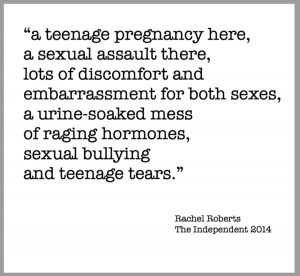 In 2014, The Independent ran an article entitled ‘Unisex toilets in schools should be avoided at all costs’. Rachel Roberts anticipated, ‘a teenage pregnancy here, a sexual assault there, lots of discomfort and embarrassment for both sexes, a urine-soaked mess of raging hormones, sexual bullying and teenage tears,’ adding, “I don’t believe that all the lads would welcome the shared space either, as teenage boys have their own insecurities.”
In 2014, The Independent ran an article entitled ‘Unisex toilets in schools should be avoided at all costs’. Rachel Roberts anticipated, ‘a teenage pregnancy here, a sexual assault there, lots of discomfort and embarrassment for both sexes, a urine-soaked mess of raging hormones, sexual bullying and teenage tears,’ adding, “I don’t believe that all the lads would welcome the shared space either, as teenage boys have their own insecurities.”
Also in 2014, children’s rights campaigner Esther Rantzen criticised Towers School and Sixth Form Centre’s plans to introduce unisex toilets.
“These children are at an age when they are extremely self-conscious and aware of their bodies and the changes they experience. It’s an extremely delicate time for them… This is one of the worst ideas I’ve ever heard and I suggest the school rethinks its proposal.”
Twitter as usual, had plenty to say on the subject of this week’s announcement.

When Chris MacGovern said he ‘feared for the well being of the children’, you could be forgiven for thinking he was indulging in a touch of hyperbole. Yet the figures surrounding sexual violence in schools are both surprising and shocking.
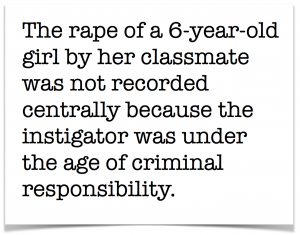 In 2017 TES revealed that in many cases schools have failed rape victims by putting them back into classrooms with their alleged attackers.
In 2017 TES revealed that in many cases schools have failed rape victims by putting them back into classrooms with their alleged attackers.
Maria Miller, chairwoman of the Women and Equalities Committee, reports some of the incidents that parents have told her about. One mother told how a primary school dismissed it as ‘playful activity‘ when her six-year-old daughter was raped by a classmate. The incident was not recorded centrally because the instigator was under the age of criminal responsibility.
This raises issues about the number of assaults among schoolchildren, how those that are reported are detected or recorded and what can be done about it. If some incidents of sexual assault involving young children aren’t being properly recorded, it suggests that the dark figures will be even higher. In what universe are unisex toilets going to help address these issues?
It is hardly surprising that parents are not happy about the idea. UK government figures show that sexual violence in schools is rising and while the government report, “Sexual violence and sexual harassment between children in schools and colleges” makes plain to stress in bold font that such assaults can occur between “children of any age and sex“, it goes on to demonstrate that it is statistically girls that are at far more risk of assault.

The Girlguiding’s Girls’ Attitudes Survey of 2017 found that 64% of girls aged 13-21 had experienced sexual violence or sexual harassment at school or college in the past year. This included 39% either having their own bra strap pulled by a boy, or witnessing it happening to another girl. Likewise 27% had either had their skirt pulled up by a boy, or witnessed it happening to another girl – within the last week.
Let’s not digress here into Girl Guiding’s new policy of allowing ‘transgirls’ (boys) to sleep in girls’ tents on camps and ‘transwomen’ (men) to run girls’ packs – without parents being informed.
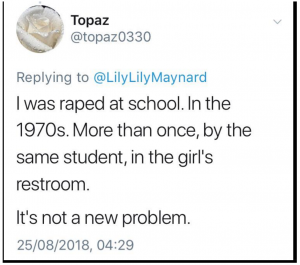 Sexual violence in schools is nothing new, but most of us assume that growing public awareness means that girls nowadays are more likely to report it and more likely to feel they will be listened to if they do. This does not necessarily seem to be the case.
Sexual violence in schools is nothing new, but most of us assume that growing public awareness means that girls nowadays are more likely to report it and more likely to feel they will be listened to if they do. This does not necessarily seem to be the case.
The Feminista report on sexism in schools,’It’s Just Everywhere’ shows that less than a quarter (22%) of female students at mixed-sex schools think their school takes sexism seriously enough.
78% of secondary school students are unsure, or not aware, of the existence of any policies and practices in their school related to preventing sexism. The report goes on to observe the cycle that is perpetuated when sexism and sexual harassment is not taken seriously.:
Even when an incident occurs that students clearly recognise as harmful and unwanted, students are currently unlikely to report it. They do not believe the teacher would take reports of sexism and sexual harassment seriously, and anticipate that they would be viewed as being difficult and oversensitive. Under-reporting contributes to a view among school leaders that sexism is not a problem requiring action – so the issue is not raised with students. This institutional silence on the matter fuels the perception (or recognition) among students that sexism and sexual harassment is considered to be ‘normal’ and unimportant, which in turn fuels a reluctance among students to report it.
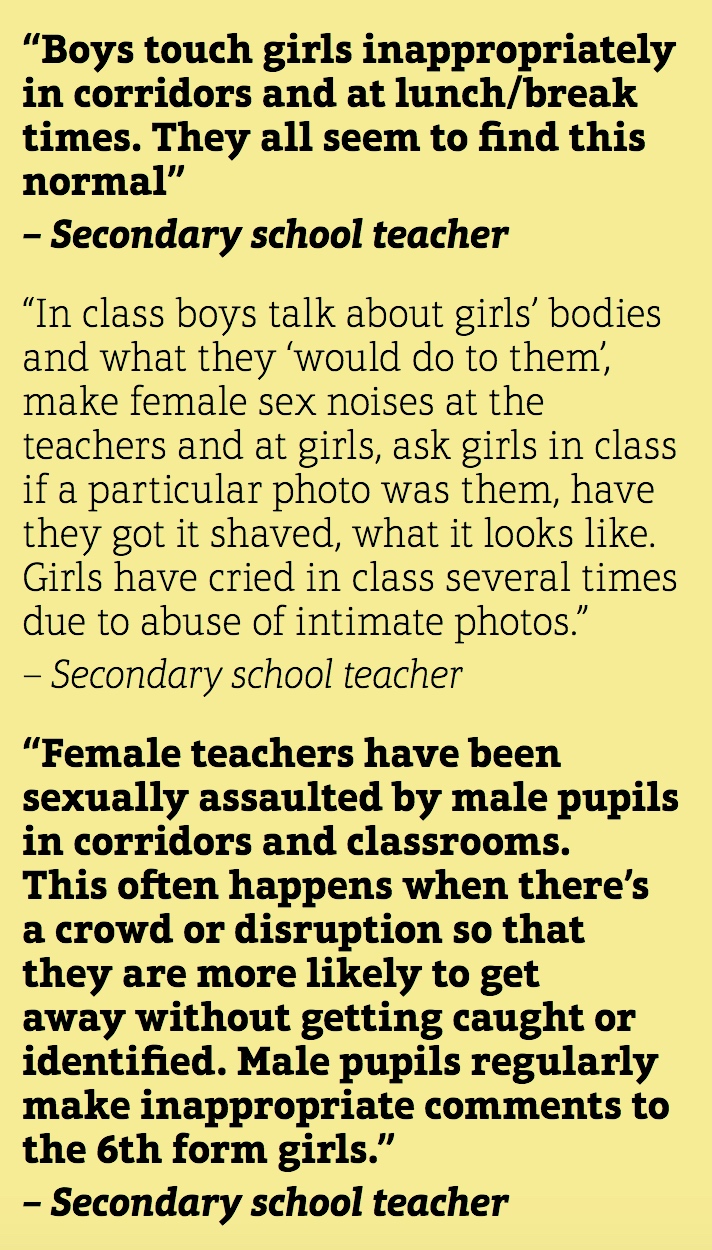 An investigation by the Press Association in 2017 revealed that children as young as five had been excluded from school for sexual misconduct. In 2017 the BBC revealed that over the previous three years, police in England and Wales had received reports of 2625 sexual offences, including 225 alleged rapes, taking place on school premises. Combined figures from 30 police forces showed reports of sexual offences by children under ten had more than doubled in the past year, from 204 to 456.
An investigation by the Press Association in 2017 revealed that children as young as five had been excluded from school for sexual misconduct. In 2017 the BBC revealed that over the previous three years, police in England and Wales had received reports of 2625 sexual offences, including 225 alleged rapes, taking place on school premises. Combined figures from 30 police forces showed reports of sexual offences by children under ten had more than doubled in the past year, from 204 to 456.
Yet this is clearly the tip of the iceberg: 11% of female students who have been sexually harassed in school say that one of the reasons they did not report it was they felt ashamed that it happened and were scared of the consequences of reporting it.
One female student said “I wasn’t aware that these incidents could be reported, no students have ever been told it is wrong to act in this way, not discouraged or punished for it.”
In 2017, the Women and Equalities commission reported that ‘Ofsted and the Independent Schools Inspectorate must assess schools on how well they are recording, monitoring, preventing and responding to incidents of sexual harassment and sexual violence.’
Nearly three-quarters (71%) of all 16-18 year old boys and girls reported that they hear terms such as “slut” or “slag” used towards girls at schools on a regular basis.
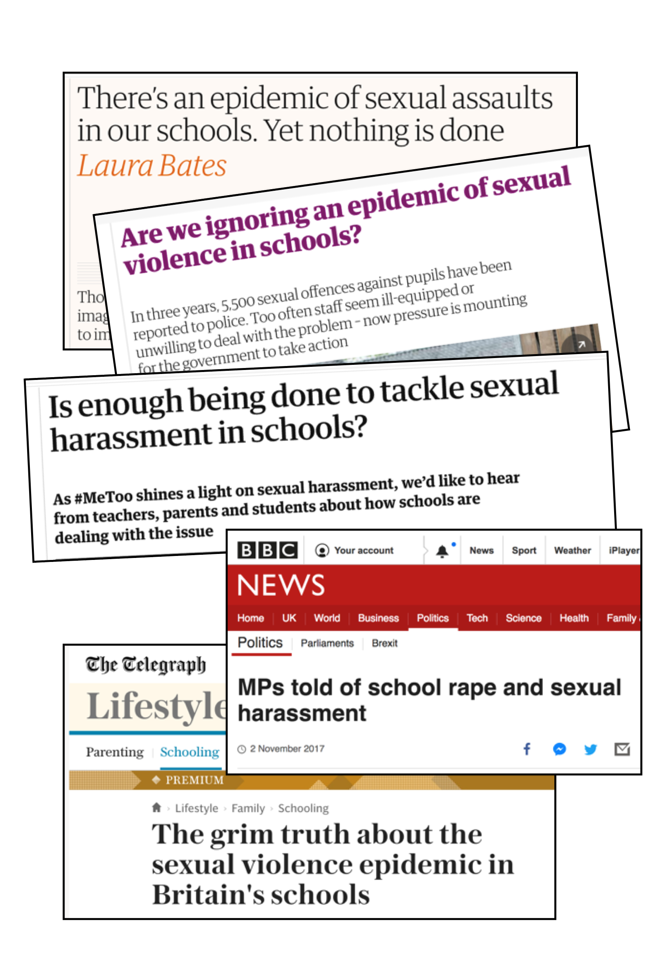 How gender neutral toilet and hand washing areas could help to minimise abuse, whether it’s one child calling another a ‘slut’ or a serious sexual assault, is a question which nobody seems to feel the need to answer.
How gender neutral toilet and hand washing areas could help to minimise abuse, whether it’s one child calling another a ‘slut’ or a serious sexual assault, is a question which nobody seems to feel the need to answer.
“Sexual harassment occurs when sexist stereotypes flourish.” said MP Maria Miller. “The Government has to show more urgency; there must be clear guidance for schools that leaves them in no doubt about their responsibilities to keep girls safe and tackle gender stereotypes, as well as support for those experiencing harassment and abuse.”
Interestingly, Maria Miller supports self-identification, the proposed changes to the gender recognition act (GRA) which will allow anyone to be legally recognised as either male or female just by declaring themselves to be so. It is hard to see how our responsibility as adults to ‘keep girls safe’ is compatible with these changes.
Bra-strap snapping, looking up skirts: these assaults may happen for a variety of reasons but they inevitably happen to female-bodied people. They happen because the victims are girls.
Take boring old ‘unisex’ and turn it into trendy, cutting-edge ‘gender neutral’ and you have a winning formula. Some schools are embracing the idea wholeheartedly.
“Gender-neutral toilets planned at all-girls school in case any pupils decide to transition” ran a Telegraph article in March 2018, reporting that a private all-girls school in Blackheath, London is installing gender neutral toilets.
The news report reads almost like a marketing ploy. Headmistress Carol Chandler-Thompson speaks to reporters about the super new toilets and the refurbishing work going on at the school in the ‘leafy London suburb’. While she currently has no trans-identified pupils, Ms Chandler-Thompson is confident that this situation will change, explaining, “I fully expect I will do.”
“We are obviously a girls’ school,” she adds, “but we may have young people who are transitioning here and we would support that… We would help them see out their education, making sure they can fulfill their own potential.”
There is an ever-increasing avoidance of mentioning that it is females – girls, women, female-bodied, XX people- that are at a greater risk of violence from males- boys, men, male-bodied XY people. More and more frequently, women speaking about their biology and how it affects them are considered to be transphobic. From pussy hats to periods, we just aren’t meant to talk about the fact that it is women who are the subject of violence rather than those perpetuating it, because admitting that might make trans-identified males feel uncomfortable.
“You don’t have men and women sharing for obvious reasons. It’s a sex issue…. ” observed Sean Donovan, father of a child at North Cambridge Academy which installed unisex open plan toilets in 2016.
A University College of London study on sexual abuse in schools determined:
“offenders are most likely to be adolescent and adult males… girls are around twice as likely as boys to be sexually victimised… sexual abuse is more likely to occur in places where risk of detection is low… victims of adolescent abusers are generally younger than for adult abusers…”
The problem with calling a girl a boy and a girl a boy, and the proposed changes to the Gender Recognition Act, is that worrying statistics like these get swallowed up within the ideology of magical thinking. If we cannot tell a male pupil from a female pupil because gender identity tops biology, what happens to the collection of statistics? If a transgirl assaults a transboy, is this recorded as a female on male assault? Statistics become meaningless and strategies cannot be developed to protect the children- mostly girls- who are being assaulted and raped. This is one of the reasons that Transgender Trend’s guidelines for schools are so important. The welfare and safety of every child must be considered.
If schools affirm that a boy is a girl, or that a girl is a boy, based on the say-so of the child- with or without the support of a parent- they are giving out two clear messages.
The first is that increased vulnerability to sexual harassment and assault is something that girls bring upon themselves by ‘identifying’ as female. The second is that this is something girls can attempt to opt out of by ‘identifying’ as male.
Whilst new-build toilets are long overdue in many schools, it isn’t the unisex aspect of the toilets that could prevent bullying but better supervision and design. Before we are so quick to leap on the idea of ‘gender neutral’ toilets as the way forward, perhaps we should think of the rights of girls- and boys- to safe spaces.
How about we make a start by giving them sex-specific privacy in the school toilets?


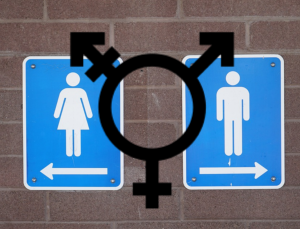
It’s so completely bizarre that while this madness is going on here in the west, in the developing world (India and Africa for instance) people are fighting for sex segregated toilets, because without them, so many girls are unable to attend school.
AND the governments of western countries support the developing countries financially to help them achieve these goals, while they happily deny their own young citizens the same privilege. The world is going mad.
All this identity bullshit is such a first world problem. People with real problems don’t have the time to waste to crawl this far up their own asses.
Thank you for all your wonderful blog posts, I read them all with great interest and am always impressed with your clarity of thought and expression. Keep up the good work!! 🙂
Pingback: ‘Gender Neutral’ Toilets? Computer says no. | Lily Maynard
Pingback: WOMEN’S AND GIRLS SAFETY MATTERS: The Vital Importance of Single Sex Toilets and Changing Rooms in Reducing Sexual Assault and Harassment - ReSistersUnitedReSistersUnited